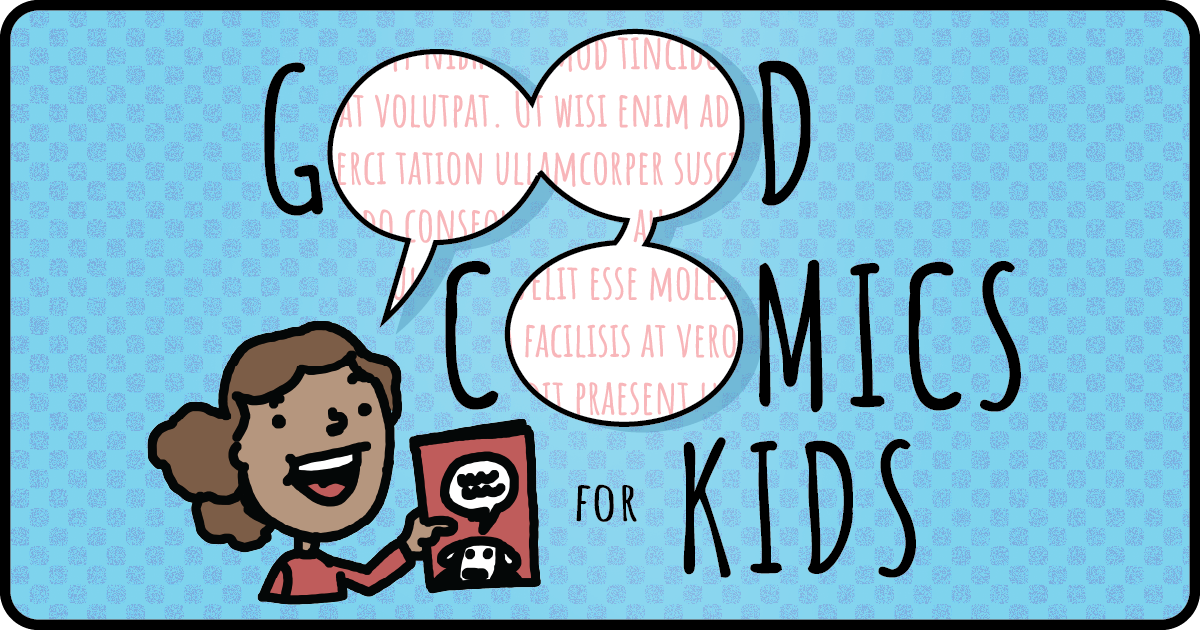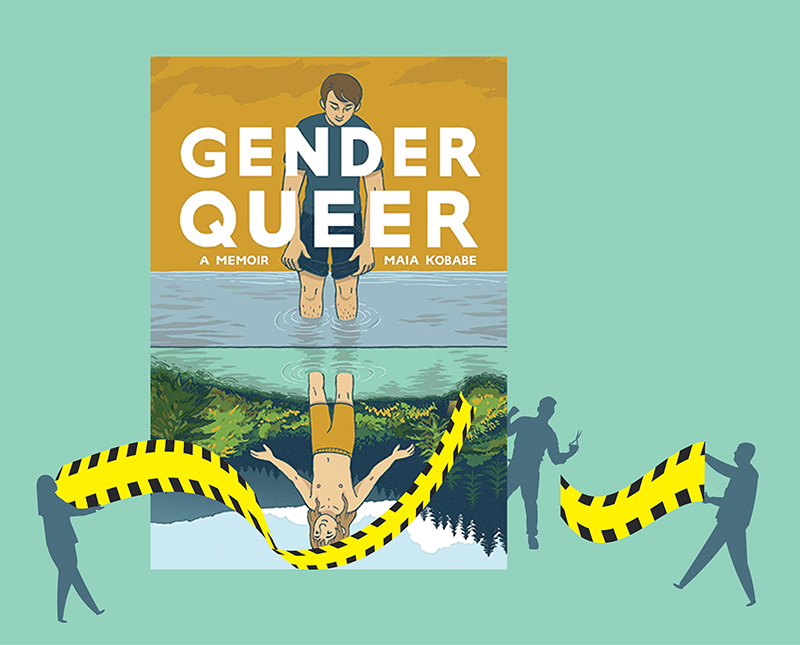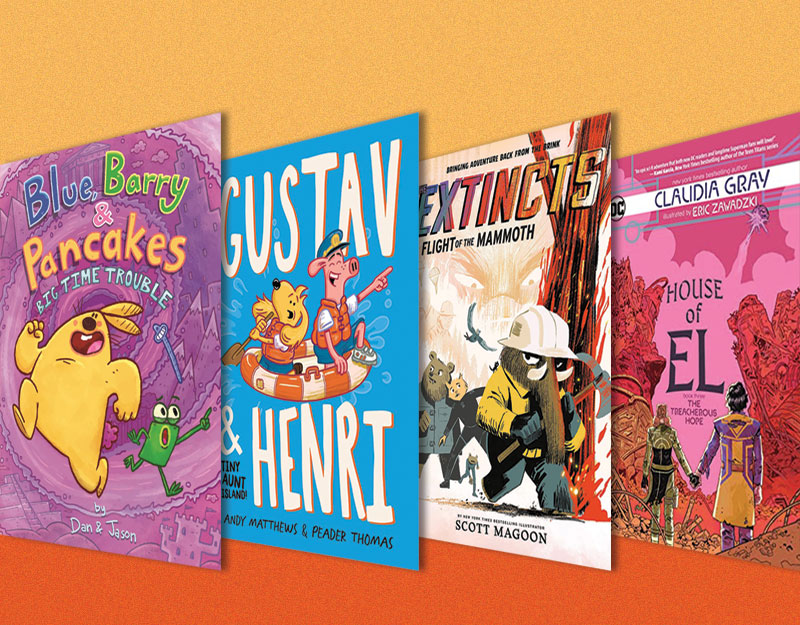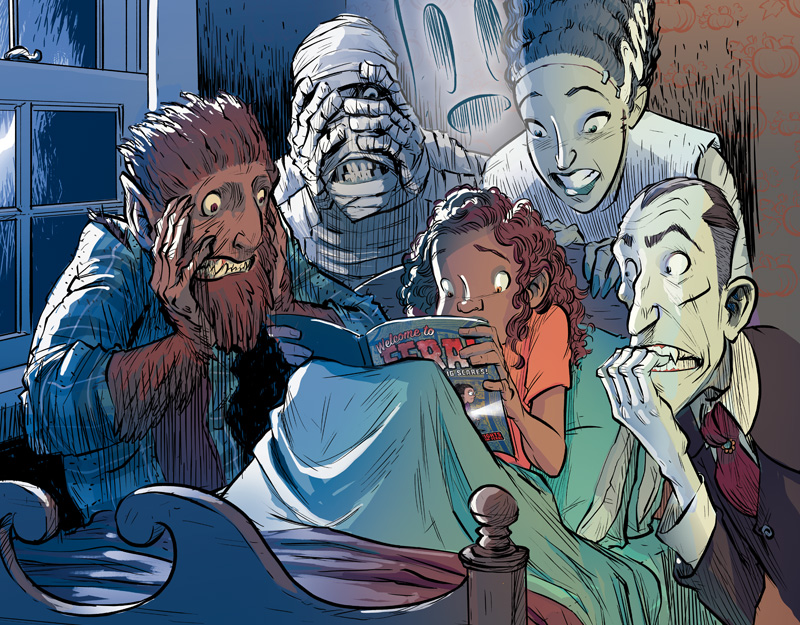The Reading Pile – December 6
Today is St. Nicholas Day; tonight, my kids will put their shoes out the door and a mysterious visitor will fill them with candy and progress reports from Santa. Here’s a progress report from the Good Comics for Kids team on what we have been reading in the past week.
 Kate Dacey: I’m working my way through a big stack of upcoming Yen Press releases. Among my favorites so far are the ninth volume of Yotsuba&!, which finds everyone’s favorite green-haired tot on a quest to find the most huggable teddy bear at a department store; the second volume of Higurashi When They Cry: Beyond Midnight Arc, a supernatural murder-mystery that is, at core, a lot like Agatha Christie’s Ten Little Indians; and the tenth volume of Goong: The Royal Palace, a sudsy manhwa in which author Park So-Hee imagines a unified Korea living under the rule of a king. The story explores the relationship between a commoner, Chae-kyeong, and the crown prince, Shin, a sullen, withdrawn hottie who’s carrying a torch for someone else. (Pops chose Chae-kyong as Shin’s bride for complicated personal reasons.) Given Prince William’s recent proposal to Kate Middleton, the subject of Goong couldn’t be more timely, even if Chae-kyeong comes from much humbler circumstances than the future Queen of England.
Kate Dacey: I’m working my way through a big stack of upcoming Yen Press releases. Among my favorites so far are the ninth volume of Yotsuba&!, which finds everyone’s favorite green-haired tot on a quest to find the most huggable teddy bear at a department store; the second volume of Higurashi When They Cry: Beyond Midnight Arc, a supernatural murder-mystery that is, at core, a lot like Agatha Christie’s Ten Little Indians; and the tenth volume of Goong: The Royal Palace, a sudsy manhwa in which author Park So-Hee imagines a unified Korea living under the rule of a king. The story explores the relationship between a commoner, Chae-kyeong, and the crown prince, Shin, a sullen, withdrawn hottie who’s carrying a torch for someone else. (Pops chose Chae-kyong as Shin’s bride for complicated personal reasons.) Given Prince William’s recent proposal to Kate Middleton, the subject of Goong couldn’t be more timely, even if Chae-kyeong comes from much humbler circumstances than the future Queen of England.
ADVERTISEMENT
ADVERTISEMENT
Also on my nightstand is Telling Tales, the latest book from Sweatdrop Studios. For Americans unfamiliar with Sweatdrop, they’re a collective of British artists who work in a variety of manga-influenced styles. Their latest book is an anthology of folk tales, from well-known chestnuts such as “Little Red Riding Hood” and “The Snow Queen” to more obscure tales such as “The Three Sisters and Their Glass Hearts” and “The Mouse, The Bird, and The Sausage.” Though most of the stories are penned by Sweatdrop regulars such as Faye Yong, Emma Vicieli, and Sonia Leong, Nightschool creator Svetlana Chmakova also contributed a short Russian folk tale, “Alenushka and Ivanushka.” The artwork and stories are diverse enough that most readers will find at least one or two that click with their own sensibilities.
Last but not least, I’m reading How to Understand Israel in 60 Days or Less, a travel memoir about author Sarah Glidden’s “birthright” tour of the Holy Land. It’s a smart, funny, and brutally honest book; Glidden spends most of the journey struggling to reconcile what she believed about the Israeli-Syrian-Palestinian conflict with what she learns from actually visiting the Golan Heights and Jerusalem. The visit also forces her to re-examine her Jewish identity; unlike many of her peers, she doesn’t immediately feel that Israel is “home,” and sometimes has strong, negative reactions to the exhibits and places she sees. It’s a thought-provoking book that I could see appealing to an older teen, perhaps one who’s contemplating a similar trip to Israel.
 Esther Keller: Friday was an exciting day for me, because I was unpacking my new (Graphic Novel) order. I didn’t want to take too much home, because I always feel bad, but I did take home the much talked about Sons of Liberty 1 by Alexander and Joseph Lagos, with art by Steve Walker. I didn’t know what to expect and don’t remember looking at reviews before ordering, so I came into this story very clean. I was really blown away. The story was exciting, riveting and interesting. But the artwork was what captivated me. I was reading with my lamp before bed and the next day took it into the sunlight to study the color and details of the drawing.
Esther Keller: Friday was an exciting day for me, because I was unpacking my new (Graphic Novel) order. I didn’t want to take too much home, because I always feel bad, but I did take home the much talked about Sons of Liberty 1 by Alexander and Joseph Lagos, with art by Steve Walker. I didn’t know what to expect and don’t remember looking at reviews before ordering, so I came into this story very clean. I was really blown away. The story was exciting, riveting and interesting. But the artwork was what captivated me. I was reading with my lamp before bed and the next day took it into the sunlight to study the color and details of the drawing.
I’m also going through a pile of the Graphic Shakespeare put out by Abdo Publishing to review for another publication. I’m not a huge Shakespeare fan, and always find that I struggle with the language, and these titles do nothing to alleviate that struggle. Yet, some of the artwork is refreshing and there are enough extras to help readers along… And perhaps this will help bridge young readers into the world of Shakespeare.

 Mike Pawuk: I’ve been pleasantly surprised by Max Brooks’ (World War Z) wonderful G.I. Joe: Hearts and Minds graphic novel. Illustrated by the legendary Howard Chaykin and also by Antonio Fuso, the book offers brief glimpses into the lives of the various soldiers who fight on the G.I. Joe team as well as their evil counterparts on the terrorist organization known as Cobra. As the title suggests, you really do get to see a glimpse of the hearts and minds of the heroes and villains, what makes them tick, and their secrets never before revealed. Max Collins has done a great job contributing to the lore of the popular G.I. Joe line and it’s a lovefest for anyone who grew up playing with the toys or watching the cartoons as a kid.
Mike Pawuk: I’ve been pleasantly surprised by Max Brooks’ (World War Z) wonderful G.I. Joe: Hearts and Minds graphic novel. Illustrated by the legendary Howard Chaykin and also by Antonio Fuso, the book offers brief glimpses into the lives of the various soldiers who fight on the G.I. Joe team as well as their evil counterparts on the terrorist organization known as Cobra. As the title suggests, you really do get to see a glimpse of the hearts and minds of the heroes and villains, what makes them tick, and their secrets never before revealed. Max Collins has done a great job contributing to the lore of the popular G.I. Joe line and it’s a lovefest for anyone who grew up playing with the toys or watching the cartoons as a kid.
I’ve been a big fan of The Simpsons Comics, but the latest issue, #172, the Christmas special, just didn’t grab me at all. Written by Mike W. Barr and art by John Costanza, it’s a mess of a story that starts off strong with Homer Simpson suffering from an overdose of too much Christmas giving, but the end the multiple sideplots of Homer selling Christmas trees in his front yard; Krusty the Clown going against his Jewish heritage to milk his popularity again; Snake committing Christmas robberies; and a Rush Limbaugh parody which goes to once again vilify Republicans as evil is just a pure mess. Better luck next year, Simpsons.
 Brigid Alverson: I’m getting into the holiday spirit with Craig Yoe’s collection The Great Treasury of Christmas Comic Book Stories. It’s big, colorful, and chock-full of delightful Christmas stories, most revolving around the logistics of Santa getting all the presents out on Christmas night, although there are also Classics Illustrated-style versions of A Christmas Carol and the nativity story. The stories are all from the 1940s, 1950s, and 1960s, and they have a classic look to them; the artists include Walt Kelly (Pogo), who draws adorable, winsome animals, and John Stanley (Little Lulu). This book is all comics—aside from a brief forward, there is no other text—and as the cover implies, the comics are all kid-friendly, with a cheery retro style.
Brigid Alverson: I’m getting into the holiday spirit with Craig Yoe’s collection The Great Treasury of Christmas Comic Book Stories. It’s big, colorful, and chock-full of delightful Christmas stories, most revolving around the logistics of Santa getting all the presents out on Christmas night, although there are also Classics Illustrated-style versions of A Christmas Carol and the nativity story. The stories are all from the 1940s, 1950s, and 1960s, and they have a classic look to them; the artists include Walt Kelly (Pogo), who draws adorable, winsome animals, and John Stanley (Little Lulu). This book is all comics—aside from a brief forward, there is no other text—and as the cover implies, the comics are all kid-friendly, with a cheery retro style.
It has been a few years since I read the first Diary of a Wimpy Kid story, and I haven’t read the intervening ones, but Diary of a Wimpy: The Ugly Truth strikes me as a tad edgier than the first book. Of course, that’s not saying much, but in this volume, Greg Heffley has had a falling-out with his best friend Rowley and has to deal with sex education, his mother’s return to the work force, and keeping up with his friends on Facebook. It’s still entertaining, but it seems to have lost a bit of the spark of the original. Still, it’s a good read, and the story is probably following its readers as they navigate the same waters.
Filed under: Uncategorized
About Brigid Alverson
Brigid Alverson, the editor of the Good Comics for Kids blog, has been reading comics since she was 4. She has an MFA in printmaking and has worked as a book editor, a newspaper reporter, and assistant to the mayor of a small city. In addition to editing GC4K, she is a regular columnist for SLJ, a contributing editor at ICv2, an editor at Smash Pages, and a writer for Publishers Weekly. Brigid is married to a physicist and has two daughters. She was a judge for the 2012 Eisner Awards.
ADVERTISEMENT
ADVERTISEMENT
SLJ Blog Network
2024 Books from Pura Belpré Winners
In Memorium: The Great Étienne Delessert Passes Away
Parsing Religion in Public Schools
Finding My Own Team Canteen, a cover reveal and guest post by Amalie Jahn
ADVERTISEMENT







